TVs become thinner and thinner and the same is true for speaker systems in our TVs. Speakers require volume but flat TVs have no room for that. So how do you get decent sound with a flat panel TV? And what options exist in the market place? In this guide FlatpanelsHD takes a look at the different sound solutions and tell you how to connect everything. We also take a peek into tomorrow’s sound solutions.
Update: Section about wireless sound has been updated as Apple and Samsung have launched wireless sound solutions.
Guide: Best sound solution for your TV
TVs have become thinner which affects sound quality. Therefore TV makers have started offering soundbars and complete surround systems but the solutions are not always pleasing to the eye. When TV makers go to the extremes to make TVs as thin as possible we sometimes wonder why the sound aspect is forgotten.
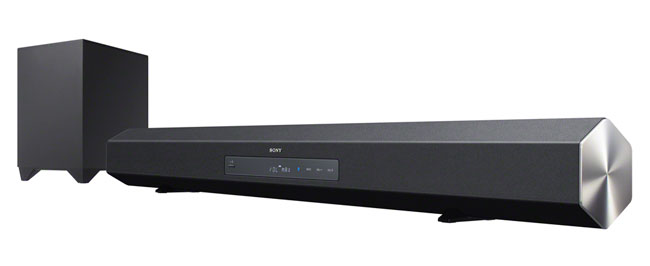
Sound bars are popular but what other options are available?
Fortunately, some TV makers still integrate decent speakers but we are still not close to the CRT days when the TV cabinets had room for good speaker solution.
The perfect sound solution for your TV does not exist. It’s about finding the best compromise
So, what to do? We start by looking at four different sound solutions and later in the article we tell you how to connect all the cables. In the last section we also take a look at the future of TV sound solutions.
The options
The list below is not exhaustive but includes four solutions that we consider the most optimal; complete with pros and cons.
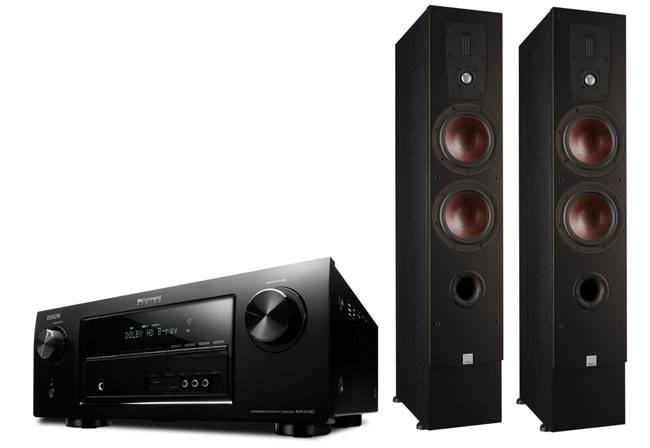
Real HiFi can provide a fantastic movie experience but it takes up a lot of space in the living room
Hi-Fi system (speakers + amplifier)
This combination has been around for ages and most are already familiar with it. You can acquire an amplifier/receiver and passive speakers and connect the TV directly to the amplifier. Passive speakers require no separate power plug and exists in so many different size classes and price classes that you can pick almost whatever you like. The setup can be extended and is flexible and allows you to create powerful 5.1 (5 speakers and a subwoofer) or 7.1 (7 speakers and a subwoofer) setups.
Pros: Powerful sound, flexible solution, surround sound, expandable
Cons: Takes up a lot of space, cable mess, very low WAF (wife acceptance factor), price
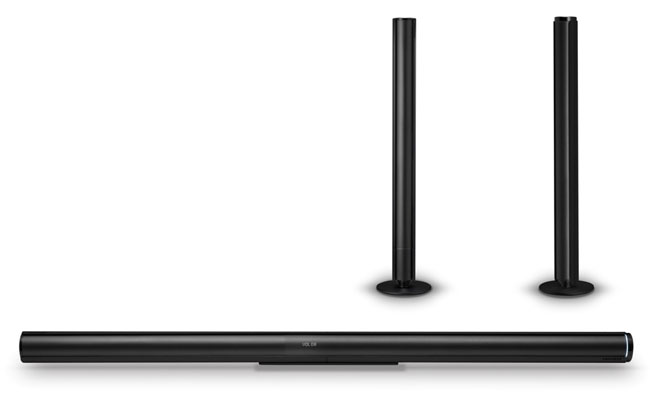
Some soundbars can be split on the middle and can be placed either below or to next to the TV, Here you see one of Samsung’s soundbars
Soundbars
Soundbars have become increasingly popular as TVs have become slimmer. A soundbar can best be described as an elongated “bar” complete with speakers and a built-in amplifier. An all-in-one solution. The number of speakers can vary and while some are pure stereo soundbars others have enough speaker units to imitate surround sound by using the room acoustics and walls. Pretty much every TV manufacturer produces their own soundbars today, made to go with their TVs’ design philosophy. But you can easily connect a soundbar from one brand to a TV of another brand.
However, in some cases it is better to combine a TV and a soundbar from the same manufacturer as it often allows you to control the sound volume with the TV remote. This should be available on all soundbars connected via HDMI but unfortunately not all TV manufacturers adhere to the standards. Some soundbars are more flexible than others as they allow you to separate it into two, thus allowing you to place the two pieces on each side of your TV. And then there are some expanded versions with built-in Blu-ray/DVD and streaming systems. Some soundbars can even receive music streams from smartphones.
Pros: Discrete solution, easy to connect, all-in-one solution, high WAF (wife acceptance factor), comes with wireless subwoofer, price point often attractive
Cons: Sound quality not necessarily great, might look strange (when it is wider or deeper than TV dimensions), often very few input connectors (no option to connect other devices)
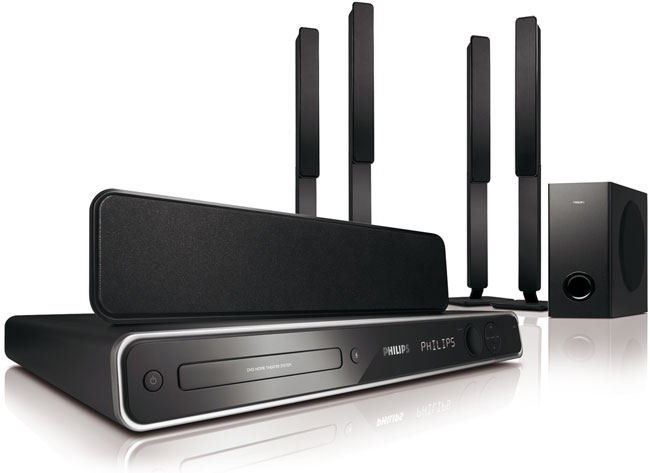
Most electronics manufacturers have started making home cinema systems that offers a complete surround sound experience and has an integrated Blu-ray/DVD/CD slot. Here you see a Philips Home Cinema system
Home Cinema Systems
If you do not want to play around with big amplifiers and large-size speakers but still want decent sound and maybe even surround sound you might want to take a look at a home cinema – or “home theater” system. You will get an integrated solution that often incorporates Blu-ray, DVD & CD players and often even wireless streaming systems. A subwoofer is often included as well and sometimes the subwoofer and rear speakers are wireless. The front speakers are connected with cables, which could prove a challenge in some living rooms.
Pure stereo systems with only front speakers also exist. These systems are true all-in-one solutions and considered the step up from a sound bar – both in size and price. The advantage of a home theater system compared to a soundbar is that you can also hook up other players and devices; a kind of “amp + speaker light” solution.
Pros: Decent sound, all-in-one solution, often matches the design of the TV
Cons: Not as good as real HiFi (amp + speakers), cable mess, often relatively expensive, medium WAF (wife acceptance factor)
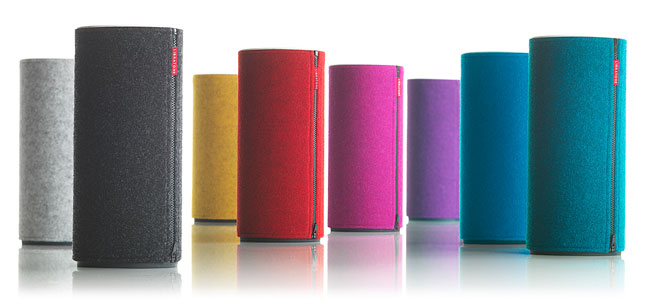
Active speakers integrates the amplifier and is in some ways similar to the soundbar solution. The speakers come in all kinds of different variants and sizes that allows for flexible placement and solutions. Here you see Libratone Zipp
Active speakers
The last option is to go with active speakers. It is not much different from the soundbar principle. The amplifier is gone as it is built into the speakers (therefore “active”) and the speakers are connected to the TV with a single cable. Compared to the soundbar solution, active speakers are more flexible and you can place them pretty much anywhere in your home. They can also connect to other devices besides the TV – they have some of the advantages of a soundbar and some of the advantages of real HiFi speakers.
Several different types of active speakers exist and they are priced very differently. Some come only with analog inputs which means that you need analog outputs in your TV (rarely seen today) but some also come with optical inputs which requires an optical cable running from the TV to the speakers but this often means that you need a separate remote to control audio volume.
Pros: Good sound, flexible solution, medium-to-high WAF (wife acceptance factor)
Cons: No extra features like a soundbar, often require analog audio connection
Throughout our guide we have focused on combining sound systems with TVs but it should be clear that these options also have different pros and cons when you also take music playback into the equation. Several systems include things such as DLNA, AirPlay or Bluetooth music streaming. Some even come with internet services such as internet radio.
How to connect
Connecting a TV to an external sound system is often cumbersome as the audio industry is still in a transition period from analog to digital
How to connect the sound system depends on your choice. Fortunately, it has become simpler to connect audio systems to TVs in the past few years.
Soundbar or home cinema systems
If there is a HDMI connection, use it. This is the easiest way to connect a TV to the soundbar or home cinema systems. With a home theater systems you should always use HDMI and connect the HDMI cable to the HDMI ARC connector on the TV as this one takes care of both picture and audio (both ways). Some soundbars come without HDMI so here you need to use the optical connection or analog audio outputs in your TV. You can also connect a soundbar directly to the headphone out plug on your TV (the TV speakers will automatically be deactivated). If you have a soundbar or home cinema system with built-in Blu-ray/DVD the HDMI cable has a double function as it also sends audio from TV channels back to sound system. This means that you only require one cable between the devices.
HiFi system
Here it gets a bit more complicated as many older amps only feature analog inputs and not many new TVs have analog outputs. In these cases it can prove difficult to connect the two. Newer amps and receives often include HDMI or optical connectors. You should prefer HDMI and then optical. If you decide to use HDMI follow the instructions above. If you use the optical cable you connect it to your TV’s optical output (it glows red) and to the amp. Then you need to switch to the profile on your amp that plays from the optical input.
However, for more complex setups – often surround sound setups – you need to take a different approach. You may have a Blu-ray player, game console or other devices and you should connect these directly to the amplifier with HDMI and then afterwards connect the amp and the TV with a single HDMI cable. Use the HDMI ARC input on your TV to ensure that audio from TV channels also streams back to your amplifier.
Active speakers
Depending on your choice of active speakers you can use either analog cables or optical. The advantage of use analog audio cables is that you can control audio volume with the TV remote. When using optical connections between the TV and active speakers you often need a separate remote for the active speakers. You can also connect the active speakers to the headphone output in the TV which automatically switches off the TV speakers.

From left to right: HDMI cable, optical cable, analog audio cable
Setup on the TV
Sometimes you need to take some steps inside the TV menus to activate external speakers. If you use HDMI everything (most times) happens automatically or you are prompted with a message box on the TV screen that helps you. If nothing happens with HDMI or you have used optical or analog cables you should navigate to the audio menu in your TV by pressing the menu button on your TV remote control. From here you can activate external speakers.
Connecting the PlayStation, Xbox, media box, CD player, etc.
Perhaps you own a PlayStation 3 or Xbox 360? You probably also own a music player and maybe even a media box. If you go with the soundbar solution you have limited connection options. The home cinema system solution is more flexible and the amplifier + speakers solution allows you to connect pretty much everything. You should try to connect all external boxes directly to the amplifier instead of the TV.
For very complex setups please ask your questions in the FlatpanelsHD forums.
The future - wireless sound?
It has become easier to connect speakers but since you have chosen to read this guide we assume that you agree that it could be even easier.
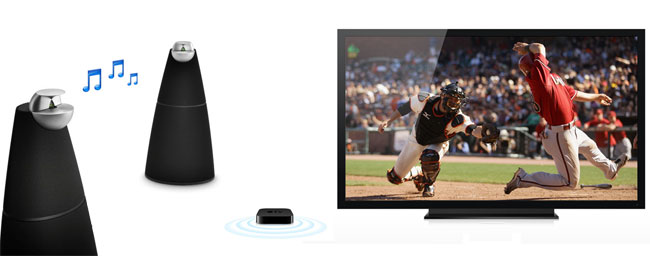
Apple is working on wireless sound that lets user stream audio from the TV to AirPlay-enabled speakers or sound systems
What will happen in the future? Some companies are working on completely wireless systems where the TV can stream audio directly to active speakers or sound systems. No audio cables required.
Update: This section has been updated as Apple and Samsung have launched wireless sound solutions.
Apple recently updated the Apple TV box to support wireless sound. So, if you watch a movie or TV series via for example iTunes or Netflix you can send out the sound wirelessly to an AirPlay-speaker. You do not have to connect any speakers to the TV. The advantages are many, as you could completely eliminate cable clutter. And because we are talking about digital audio and AirPlay everything happens with no loss of audio quality – why not use a wireless network instead of expensive cables?
You can see our guide use wireless sound on Apple TV here.
Samsung has also released its first wireless soundbar that only requires a power cable. However, it only works with Samsung’s own 2013 TVs. Learn more about it here.
Samsung has also demonstrated an interesting solution. It is a dedicated sound system but instead a variant of Samsung’s 3D glasses with built-in headphones that receive wireless audio from the TV. A similar solution without 3D glasses could be on its way but Samsung has not confirmed anything yet.
You can learn more about it here.
This is obviously the first baby steps of the future and the first solution only works by adding an extra box to the setup. We look forward to the near future when our living rooms get “smarter” so we can stream everything wirelessly.
Which sound system do you use? Do you have a soundbar or maybe something completely different? Tell us about you setup and share your tips in the comments.



